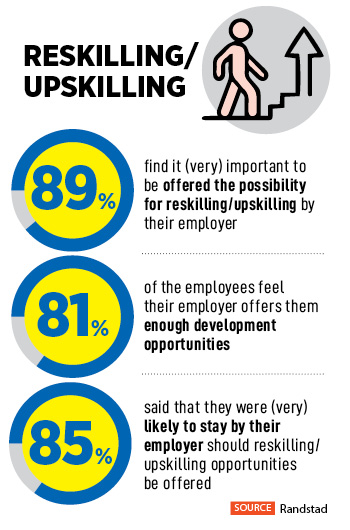
Inside the not-so-quiet hustle, quit and fire culture
Employees are responding to inhospitable work culture with mechanisms like quiet quitting or quiet hustling, while employers are resorting to quiet firing to express their dissatisfaction
 The practice of quietly addressing workplace problems without an active discussion or intervention isn’t a new phenomenon, but machanisms like quiet quitting, quitting hustling and quiet firing are being discussed more openly than before.
Illustration by: Sameer Pawar
The practice of quietly addressing workplace problems without an active discussion or intervention isn’t a new phenomenon, but machanisms like quiet quitting, quitting hustling and quiet firing are being discussed more openly than before.
Illustration by: Sameer Pawar
What Singh is doing can also be termed as “quiet hustling”. Quiet hustlers are people who work extra hours for something they want to do outside of the scope of their primary employment.
Food delivery startup Swiggy recently announced an industry-first policy enabling employees to take up gigs beyond work hours. “Any project or activity that is taken up outside office hours or on the weekend, without affecting productivity, and does not have a conflict of interest, can be picked up by the employees. The employee will have to declare a few necessary details so that the team can greenlight the project,” reads the startup’s note. In contrast, Infosys recently sent an email to the employees saying “No two-timing, no moonlighting”.
Anjali Raghuvanshi, chief people officer at HR consulting firm Randstad India, believes that employees who have opted to quit hustling or have taken up additional secondary jobs are primarily doing so for financial reasons. “Especially as they have had to put in extra hours at work during the pandemic without any additional compensation. Most employees do not inform their employers about a second job and IT companies especially have been against the practice,” she says.
In the event of an expectation mismatch for the employee at their primary workplace, some choose to quietly pick up a side hustle, while others choose to quietly quit. The practice of quietly addressing workplace problems without an active discussion or intervention isn’t a new phenomenon, but it is being discussed more openly than before. Quiet quitting is an employee’s response to unmet workplace satisfaction, and quiet firing is an employer's response to dissatisfaction with their employees. Quiet hustling is working on a side business along with a primary job.
Ananya Sharma (name changed) entered the advertising world as a digital marketer last year after completing her graduation. New to agency life, Sharma was eager to work hard and prove her worth. “When I joined initially I used to go the extra mile, work much beyond the specified hours, pull all-nighters and whatnot,” says Sharma. But this didn’t yield fruit.

“All my effort and hard work was never appreciated. My seniors feel it is my duty to work overtime and deliver results irrespective of how taxing it would get. They [her seniors] believe that work should become our lives. Everything else should be sidelined,” says Sharma, who, for a while, succumbed to the idea. “I am being paid less than my peers in other organisations and have an unhealthy work environment with HRs and leaders dumping work on us and not addressing our concerns. I let all these things go, initially since it’s my first job,” she says.
Because of the unethical treatment of employees, as she put it, Sharma has now stopped putting in the extra effort. “Now I only work for the fixed work hours for which I’m being paid,” she retorts. “My leaders know I’m not giving my best. I tried to reason with them once, but the HR’s response was defensive enough to make me feel bad about myself,” she says. Sharma has now decided to quit, after months of quietly quitting.
The Gen-Z Paradigm Shift
Just like Sharma, the propagation of the hustle culture—where one is expected to go above and beyond for their primary work— doesn’t sit well with many young employees of today. For them, work-life balance is as important as productive work.
As more and more millennials and Gen-Z candidates join India’s workforce, their expectations and attitudes are very different from previous generations, explains Neeti Sharma, president and co-founder of the edtech arm of Teamlease, a recruitment platform. “Being digital natives, Gen-Z looks for access to a youthful workplace, continuous engagement, motivation, and opportunities to upskill and grow in their career faster. We as employers must understand that flexibility is the key requirement for this generation,” she adds. The Randstad Employer Brand Report that was released in July and covers 3569 companies points to this shifting preference, with around 68 percent of the workforce preferring flexible working hours as opposed to only 32 percent who are willing to work fixed hours.
Recently, a few startup founders posted their idea of an ideal candidate on social media, which sparked a conversation around unrealistic expectations in the name of ‘hustling’.
Shantanu Deshpande, CEO of Bombay Shaving Company, advised freshers to work "18 hours a day for at least 4-5 years" in a post on Twitter. Harsimarbir Singh, co-founder of health tech company Pristyn Care, shared the process of shortlisting a candidate and called it “Interesting Interview hacks" that he said used “early on to filter for Special Driven people". He also said the company gets the candidate to spend 6-8 hours in the office before the interview to see their culture and patience, does in-person interviews at 9.00 pm to check if they can work long working hours, and regularly does Sunday interviews to find out their extraordinary commitment. He also stated that, for outstation candidates, the company asks them to show up the next day to see their “hustle". All these statements received backlash on social media, forcing the recruiters to take down their posts.
The Quiet Response Culture
Experts believe as long as the employees are not hindering their current work profile, they should be allowed to do something they’re passionate about, with only one condition that they don’t misuse this liberty.
The conversation around these practices started with quiet quitting buzzing the social media when a 20-year-old endorsed it on TikTok, which then snowballed into an increased focus on the practices like quiet firing and quiet hustling.

There have been countless takes on quiet quitting. Supporters argue that it is a way to safeguard employees’ mental health, prioritise family, friends, and passions, and avoid burnout. But many leaders and recruiters are against it. “While quiet quitters may feel they are doing the right thing by giving themselves adequate personal time, however, they aren’t doing enough to enhance their professional careers,” says Sharma of Teamlease Edtech.
Quiet Firing
Shreya Shah (name changed) was recently forced to resign by an event tech startup in Ahmedabad. There was no process of firing, she explains. The company gave her two choices, either take up a performance improvement plan (PIP) or resign voluntarily with an immediate effect. The startup has been going through a turmoil for the past few months and it officially laid off 50 employees in July. Shah, who worked with the company for four years as a sales representative, was sure about not opting for a PIP because according to her she didn’t do anything wrong. “The company already laid off many people officially and to avoid gaining more attention, they didn’t want to remove me and some more people officially and hence they designed the whole plan of removing me, reminding me of a mistake I made two years ago.” Twenty-eight-year-old Shah has been jobless for the last three weeks and is hunting for a new job.
Quiet firing usually happens when the employer plans to downsize their teams as the company isn’t doing well, and this method differs from formal layoff. Quiet firing occurs when a leader or manager does not want to have a tough conversation with a particular employee about his/her performance, feedback, or expectations. Instead of coaching them and giving them feedback, the manager slowly starts moving them away from key tasks as means of obstructing promotions, career progression and putting the employee on PIP. “Both quiet quitting and quiet firing reflect a work culture where employees are not engaged or offered the desirable compensation for work,” says Raghuvanshi.
Quiet quitting is a response to the quiet firing, explains Seema Rekha, managing director of Antarmanh Consulting, a management consulting firm. “When leaders fail to communicate and explain the rationale behind quiet firing to the team, the existing team members ' insecurities make them look for other options. And when they are not able to find other opportunities with similar benefits, they start feeling stuck. Poor self-awareness and lack of communication on employers' part leads them to quietly quit,” she explains.
Poor Management, Employee Burnout
Burnout and insufficient reward for the expected hard work are the key aspects of an employee opting for quiet quitting. In the Gallup 2022 State of the Global Workplace report, researchers highlighted that the global workforce’s high-stress levels in 2021 surpassed early pandemic levels in 2020. South Asia, with India topping the list, had the lowest well-being globally at 11 percent. The Gallup research also shows that 70 percent of the variance in employee engagement can be tied back to the manager.
“I’ve had the worst experience with my manager, one where she felt like I’m her property,” says a 23-year-old content writer who worked with a D2C startup until last month, on the condition of anonymity. “I used to enter the office and she’d start pin-pointing flaws, not only in my work but my appearance as well. She’d burden me with excessive work with unrealistic deadlines. Once, she even wrote an email with the subject line as termination of an employee with my name right in front of me, just to threaten me.” This being her first job and her unfamiliarity with employment laws led her manager to say things like “you don’t get an official off for your first six months of working” and “work should be your only priority”.

The hostile culture and her manager’s approach led the content writer to doubt her abilities and she couldn’t perform. From being scared initially by the threats to not putting in the effort, she resorted to quiet quitting for three months before finally deciding to quit.
A 2022 Harvard Business Review article, which analysed 2,801 managers who were rated by 13,048 subordinates, highlights that bad managers are the key reason behind quiet quitting. The authors, Jack Zenger and Joseph Folkman, co-founders of leadership development consultancy Zenger/Folkman, state that quiet quitting was “usually less about an employee’s willingness to work harder and more creatively, and more about a manager’s ability to build a relationship with their employees where they are not counting the minutes until quitting time.”
As businesses across sectors approach recovery, both senior management, managers, and junior and mid-level employees work additional hours causing a social disconnect due to a lack of time to interact informally, explains Raghuvanshi of Randstad. “A lack of feedback and face-to-face conversations might lead to lower engagement and motivation among employees. Many employees have also reported not receiving incentives by way of promotions and increments for extra hours being put in by them.”
Sumit Sabharwal, CEO, TeamLease HRtech, says that a lack of feedback opportunities is also a key reason for employee dissatisfaction. “I think a lot of organisations don’t have the feedback from the system that these problems exist, it’s not the lack of intent, but the lack of awareness. And yes, these form the core reasons for an unhealthy employee-employer relationship.”
“While quiet quitting is more prevalent among the younger demographic, dissatisfaction at work is a largely common scenario across all age groups in the workforce,” comments Raghuvanshi. Around 50-55 percent of the workforce are reportedly burnt out at work and around 48-50 percent employees have rated their work-life balance as poor, as per the Randstad report.
Work-life Balance Manifesto
Employees are looking to join and stick with organisations where they can expect growth, learning opportunities, profit-sharing, flexibility, and cultural alignment, says Raghuvanshi.
“A company needs to see the human in the human resources and genuinely consider our resources,” says Ananya Sharma, the digital marketer. “Instead of setting unrealistic expectations, effort should be made to arrive at a profitable agreement for both employee and employer,” she adds. Learning from her current employment experience, Sharma is now looking for job openings where work-life balance is prioritised. “Now whatever job interview I’ll appear for, I’ll see if they ask my perspective on the job role and not blindly throw their expectations on me,” she says.
It is increasingly noticeable that this generation understands their value and are willing to ask for what they feel is fair, explains Sharma of TeamLease Edtech.”Employers and employees may not always see eye-to-eye but it is essential that two-way communication is maintained about all issues that affect India Inc.”
Singh, who has been a quiet hustler, plans to leave his current job soon and shift his focus completely to run the business. “The pandemic gave me a push to start this business that I had been planning for many years. I’m happy it happened finally and I’m considering devoting myself to it full-time, very soon,” he says.
Akhil Gupta, CEO of the online recruitment platform shine.com, says that any organisation’s growth is hampered if it doesn’t keep employees at the heart of its operations. “Employees expect to be treated respectfully, appreciated, compensated fairly, and provided with appropriate direction and communication by the leadership team. A lack of this sentiment can make the workplace a minefield of negative emotions. This undermines the organisation's efforts to create a high-performance and productive work environment,” he says, arguing that technology should be used to gauge employee satisfaction, gather feedback on policies, and increase leaders’ communication with their employees.
Post Your Comment

















